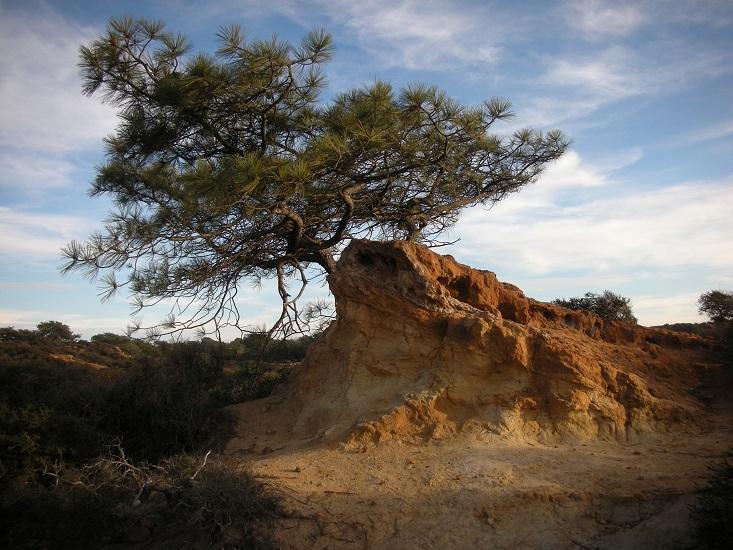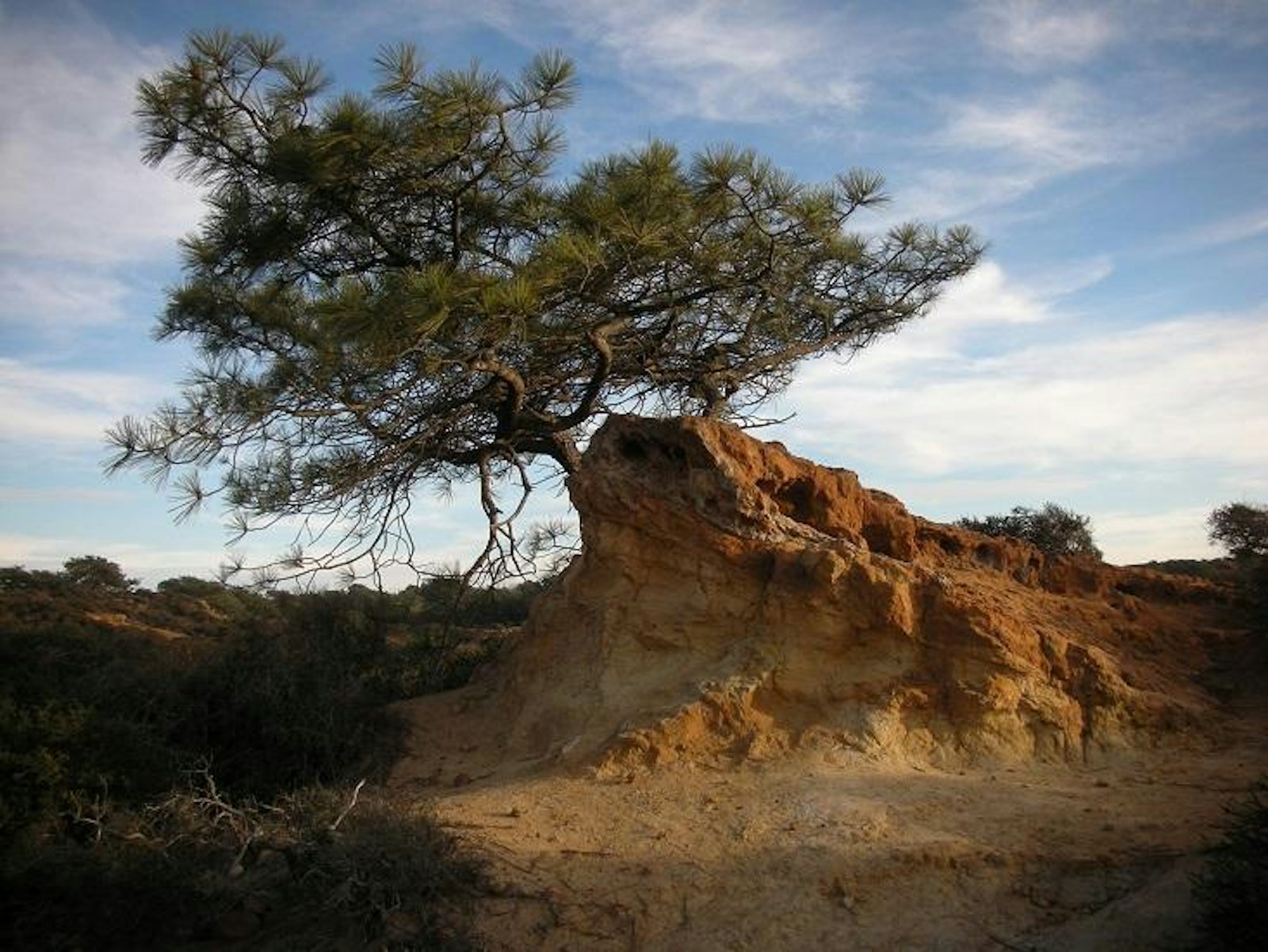Torrey pines seem like they could use some human help. According to the U.S. Forest Service, they are the rarest pine species in North America, with fewer than 10,000 trees growing in the wild. They’re split between Santa Rosa Island, off California’s southern coast, and a small state forest perched on the coastal bluffs just north of San Diego. Battered by the sea wind and salty air, they can take on beautiful sculptural shapes resembling bonsai trees; they’re also threatened by bark beetles, drought, air pollution, and fire, and are barely reproducing.

Climate change, projected to increase temperatures and the length of dry spells in the region, will likely make things worse. They would probably be better off a few hundred miles up the coast, where the climate is cooler and wetter, but (being trees) they’d have a tough time getting there on their own. It’s a quandary scientists and conservationists have spent decades debating: Should humans step in and help the Torrey pine, and other trees in a similar predicament, migrate?
Biologists Robert L. Peters and Joan Darling were the first to weigh this option, in the 1980s. The effects of climate change will likely shift or shrink the natural ranges of many species, they wrote in Bioscience, and those that are unable to cross natural or manmade boundaries could face extinction. Trees would face some of the biggest threats, they wrote, because they are relatively immobile (their seeds disperse) and slow to reproduce. Many ecologists argue that humans should help endangered trees move—a practice usually called “assisted migration.” “It’s simply planting the trees into climates where they’re adapted,” says Jerry Rehfeldt, a retired Forest Service geneticist, and an early proponent of assisted migration. Though it might seem like a new tactic, in many ways, assisted migration is no different from what foresters and gardeners have done for hundreds of years. “The concept has been around for a long time,” Rehfeldt says.
Foresters, for example, have done this to maximize timber yields for many tree species, including the Torrey pine. While it may be rare in the wild in the U.S., Torrey pines are widely planted as ornamentals, and are grown for timber in plantations as far away as Australia and New Zealand. It’s possible the Torrey pine could become extinct in its natural range, but there’s almost no danger of it disappearing as a species. Assisting its migration, then, isn’t just about saving a unique set of genes, but also about saving the unique environment those genes are a part of.
As good as that sounds, other ecologists are wary of stepping in, citing the numerous examples of translocated species that have turned into invasives—organisms that destabilize the ecosystems they’re introduced to. Invasive trees wipe out native stock and cost the United States economy $120 billion every year, the Nature Conservancy estimates. Although few invasive species got their start by assisted migration, the broader lesson applies—moving species around often brings unintended consequences. What’s more, says Adrian Das, a US Geological Service ecologist at Sequoia National Park, assisted migration is likely not a one-time fix. Climate change could continue for hundreds of years; moving the trees once might not be enough. Koren Nydick, the park’s science coordinator, says scientists at the park have nonetheless “discussed proposing a small-scale trial of assisted migration.” Das isn’t against the idea but, given long-term increasing temperatures, “where does [assisted migration] stop?” he says. “We need to be asking these sorts of questions.”
In the meantime, says Connie Barlow, a retired science writer and amateur ecologist, climate change is endangering thousands of species and their ecosystems. Not inclined to wait for definitive answers, she struck out on her own, probably becoming the first to actually launch an assisted migration effort for trees as a conservation project.
“Somebody needs to be radical,” Barlow says.
In the early 2000s, she began collecting Torreya taxifola seeds from trees growing in a botanical garden in Asheville, North Carolina. Like the Torrey pine, it’s extremely rare in its natural range, surviving only on the Florida border adjacent to southwest Georgia. The tree was once common enough to be harvested for timber, but in the 1950s its population crashed. Fewer than 1,000 trees remain and, unlike the Torrey pine, it is not widely planted as an ornamental or grown for timber—so it may very well go extinct. Together with other members of Torreya Guardians, Barlow has since helped to plant hundreds of seedlings in North Carolina, Virginia, Tennessee, Ohio, and even as far north as New Hampshire. “Somebody needs to be radical,” she says.
Many scientists have been critical of Barlow’s efforts, describing her as a vigilante. Mark Schwartz, an ecologist and Torreya tree expert, argued that while the Torreya tree was unlikely to turn invasive, helping it migrate would set a dire precedent, giving amateur conservationists license to move species wherever and whenever they felt it necessary. “Conservationists must have clear guidance as to when this action is warranted and when it is not,” he wrote in the now-defunct magazine Wild Earth, in 2004. “It is not an action to be taken lightly.”
Schwartz’s fear that Barlow would set a precedent doesn’t seem to have come true. She says she’s frustrated that few others are following her lead. While commercial foresters have begun routinely thinking about the effects of climate change on their trees, not-for-profit assisted migration projects remain rare. For the immediate future, assisted migration of forests seems likely to remain informal, driven less by any coordinated desire to save rare species and ecosystems, and more by commercial interests or individual whim.
Sometimes, though, the motivation for assisted migration doesn’t matter: While researching Torrey Pines, I heard about a stand that had been planted by homesteaders in Big Sur, hundreds of miles north of San Diego, in the 1940s. The grove has spread down the cliffs and across Highway 1, and where the trees are exposed to wind and salt spray off the ocean—like on the bluffs just north of San Diego—they grow twisted and sideways, says wilderness guide and consultant Steven K. Harper, and appear to be thriving.
Zach St. George is a freelance reporter based in California, writing about science and the environment. Follow him on Twitter @ZachStGeorge.






























